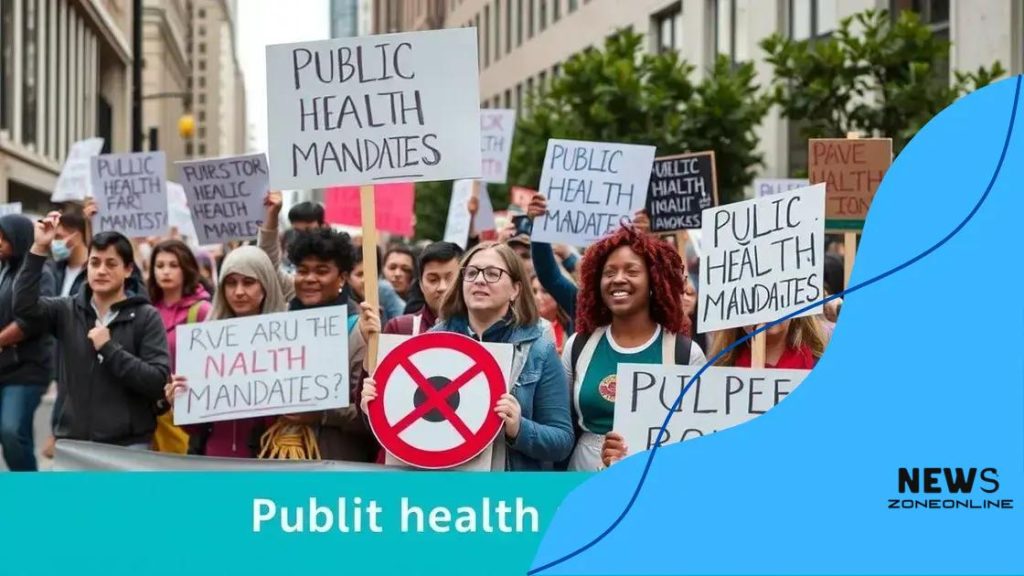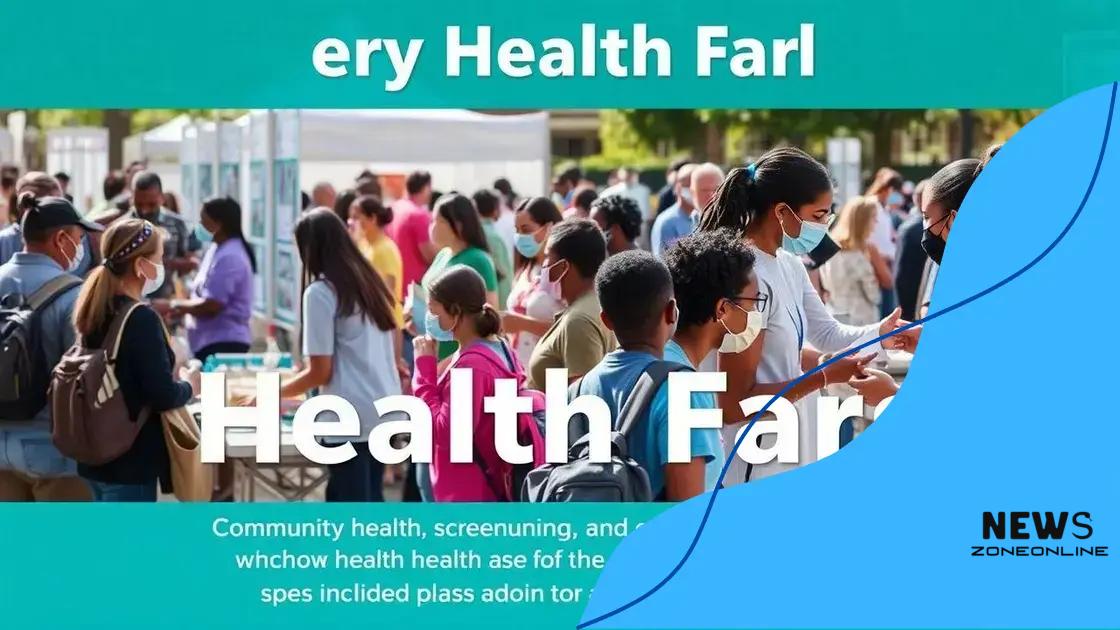Public health mandate resistance and its implications

Public health mandate resistance is driven by concerns over personal freedoms, distrust in authorities, and misinformation, necessitating effective communication and community engagement to improve understanding and compliance.
Public health mandate resistance has become a significant topic in recent years, as more individuals question government and institutional directives. What factors drive this pushback? Let’s dive into the complexities behind this movement.
Understanding public health mandates
Understanding public health mandates is crucial in today’s world, where health crises often require swift action. These mandates play a vital role in protecting community health by implementing measures that curb the spread of diseases.
Public health mandates can include measures like vaccination requirements, quarantine regulations, and mask mandates during health emergencies. These regulations are often guided by scientific evidence and aim to safeguard the overall well-being of the population.
The purpose of public health mandates
The primary aim of these mandates is to control the outbreak of contagious diseases. By enforcing specific actions, public health officials can minimize health risks to the community. Here are some reasons why public health mandates are essential:
- They help reduce disease transmission.
- They protect vulnerable populations.
- They ensure healthcare resources are available.
- They build community immunity through vaccination.
When a public health crisis arises, experts assess the situation and determine necessary actions. This process involves reviewing data and understanding community needs. The mandates are not arbitrary; they are based on thorough research and expert recommendations.
Challenges in implementing mandates
Despite their importance, public health mandates often face resistance from certain groups. Some individuals question the authority behind these mandates and express concerns over personal freedoms. This resistance can complicate the implementation of effective public health strategies.
Engaging the community is vital when discussing mandates. Health officials must communicate clearly about the rationale behind these measures. Strategies may include:
- Providing detailed explanations of the health benefits.
- Addressing public concerns through open dialogue.
- Offering transparent data to support recommendations.
Ultimately, understanding public health mandates involves recognizing their complex nature and the challenges they face. As we navigate health crises, it’s essential for communities to come together and support measures that protect everyone’s welfare.
The rise of mandate resistance
The rise of mandate resistance highlights significant societal reactions to public health policies. Over recent years, many individuals have expressed concerns about mandates imposed by governments and health organizations.
Resistance can stem from a variety of factors, including personal beliefs, misinformation, and fear of loss of freedom. These feelings often lead to public demonstrations, social media campaigns, and other forms of activism. It is crucial to understand the reasons behind this resistance to foster a more constructive dialogue.
Factors contributing to mandate resistance
Several key factors have contributed to the growing pushback against public health mandates. Understanding these elements is vital for addressing community concerns. The main contributors include:
- A loss of trust in authorities and institutions.
- Fear of potential health risks related to vaccines or treatments.
- Perceptions of personal freedom versus societal responsibility.
- Misinformation spread through social media platforms.
As these concerns arise, it becomes essential for public health officials to engage with the community and address these fears directly. This involves open communication and transparency about the reasons behind the mandates.
Community responses to mandates
Community responses can vary widely, with some groups strongly opposing the mandates. Protests and rallies often take place, showcasing the voices of those who feel their rights are being infringed upon. In contrast, many community members support mandates, recognizing them as necessary for public health. This divide can create tensions within communities, requiring effective mediation and understanding.
To bridge this gap, effective communication strategies are essential. Providing clear, accessible information about the benefits of mandates can help mitigate fears. Including community input in discussions about health policies may also reduce resistance.
Recognizing the rise of mandate resistance is crucial for developing future public health strategies. By understanding community perspectives and addressing concerns proactively, it is possible to foster a cooperative relationship between authorities and the public.
Impacts on community health

The impacts on community health due to public health mandates are significant and multifaceted. These mandates aim to protect the health of the population, but their implementation can lead to various consequences for communities.
One major area of impact is in the reduction of disease spread. By implementing mandates such as vaccination requirements or mask-wearing policies, communities can experience lower infection rates. This not only protects individuals but also alleviates the burden on healthcare systems.
Positive effects of public health mandates
Public health mandates often bring about positive outcomes for community health. Here are some of the key benefits:
- Increased vaccination rates help establish herd immunity.
- Reduction in hospitalizations due to fewer infections.
- Improved public awareness of health issues.
- Encouragement of healthy behaviors through community programs.
These benefits collectively enhance the overall well-being of the community. When people feel safe, they are more likely to participate in social and economic activities, promoting a healthier environment.
Potential challenges
While public health mandates can lead to improved outcomes, they may also create challenges. Some community members feel that mandates infringe upon personal freedoms, leading to resistance. This discomfort may manifest in protests and social unrest, which can further divide communities.
Moreover, misinformation and distrust can spread rapidly, undermining the effectiveness of mandates. Engaging with the public to address concerns is crucial. Providing accurate information and fostering dialogue can help decrease resistance and enhance compliance.
Understanding the impacts on community health involves a careful consideration of both the benefits and potential downsides of public health mandates. By focusing on community engagement and education, health officials can work towards maximizing positive outcomes while minimizing resistance.
Legal perspectives on mandates
The legal perspectives on mandates play a critical role in how public health policies are implemented. Governments often invoke legal authority to enforce health mandates, which can include vaccination laws, quarantine measures, and mask requirements.
The legal foundation for these mandates typically rests on public health laws that have been established to protect the community’s well-being. Courts have historically upheld the right of authorities to impose health mandates during emergencies, emphasizing the necessity of such actions to combat disease outbreaks.
Key legal principles
Several key legal principles underpin the enforcement of public health mandates, including:
- Police powers: Governments can enact laws to protect public health and safety.
- Due process: Individuals must have the opportunity to challenge mandates that affect their rights.
- Precedent: Court decisions in previous cases shape current interpretations of health mandates.
- Religious and medical exemptions: Legal frameworks often allow for exemptions based on personal beliefs.
These principles help balance the government’s responsibility to protect public health with the rights of individuals. Understanding these legal aspects is essential for navigating debates surrounding mandates.
Challenges and considerations
Despite the legal foundation, challenges to mandates can arise in various forms. Individuals may argue that mandates infringe on personal freedoms or violate constitutional rights. Legal battles surrounding mandates can create divisions within communities and complicate public health efforts.
Furthermore, as events unfold, courts may face the challenge of adapting legal interpretations to new public health realities. Ensuring compliance with mandates can also be a legal grey area, especially concerning enforcement measures.
Ultimately, the legal perspectives on mandates inform how society responds to health crises. Clear legal frameworks and transparent communication about the rationale behind mandates can help mitigate disputes and enhance public trust.
Strategies for effective communication
Effective communication is essential when discussing public health mandates. This communication helps to clarify the purpose of mandates and addresses any concerns the community may have. Clear messaging can foster trust and compliance.
One strategy involves using simple and direct language. Messages should be easy to understand, avoiding complex medical jargon. This approach ensures that everyone in the community can grasp the key points. Consistent messaging across different platforms is also crucial.
Utilizing multiple channels
Leveraging various channels can enhance the reach of important health messages. Different demographics may respond better to specific media. Here are some effective channels to consider:
- Social media: Engage with the community on platforms where they are active.
- Community meetings: Host discussions to address questions and concerns face-to-face.
- Local radio and TV: Use these platforms to reach a broader audience.
- Brochures and flyers: Distribute printed materials in public places, like libraries and clinics.
By utilizing diverse platforms, public health officials can ensure that their crucial messages reach all segments of the community. People can connect better when they receive information through channels they trust.
Incorporating community feedback
Another important strategy is to incorporate community feedback into communication efforts. Listening to concerns and suggestions allows health authorities to tailor messages effectively. Surveys and public forums can be valuable tools for gathering this feedback.
Translating materials into multiple languages can also enhance accessibility. Understanding cultural differences and addressing them in communication can help build confidence in public health mandates. By demonstrating that the authorities value community input, officials can strengthen their relationships with residents.
Overall, implementing these strategies for effective communication is vital for achieving public health goals. By being responsive and clear, officials can help ensure that the community understands the importance of health mandates and supports them.
FAQ – Frequently Asked Questions about Public Health Mandates
What are public health mandates?
Public health mandates are regulations imposed by governments to protect community health. They can include vaccination requirements, mask-wearing, and quarantine measures.
Why do some people resist public health mandates?
Resistance can arise from concerns about personal freedoms, distrust in authorities, or misinformation about health guidelines.
How can effective communication help with mandates?
Clear communication can address community concerns, build trust, and encourage compliance with public health measures.
What strategies can be used to engage the community regarding mandates?
Utilizing multiple communication channels, incorporating community feedback, and providing multilingual materials can enhance engagement and understanding.





